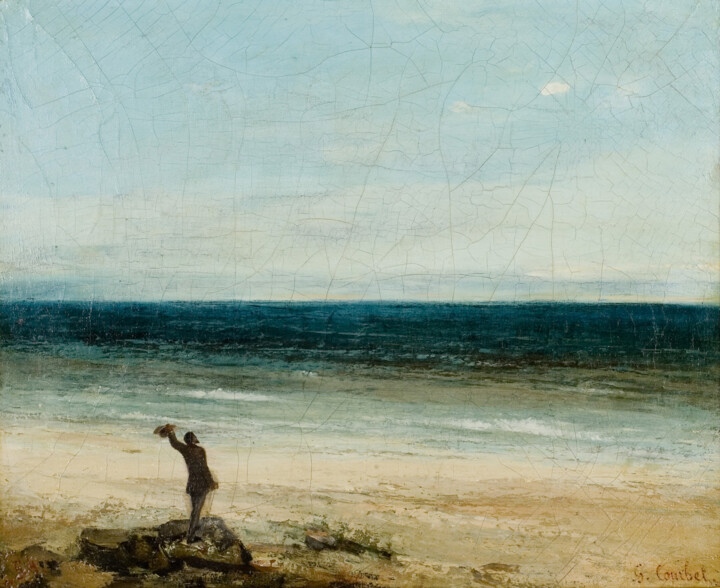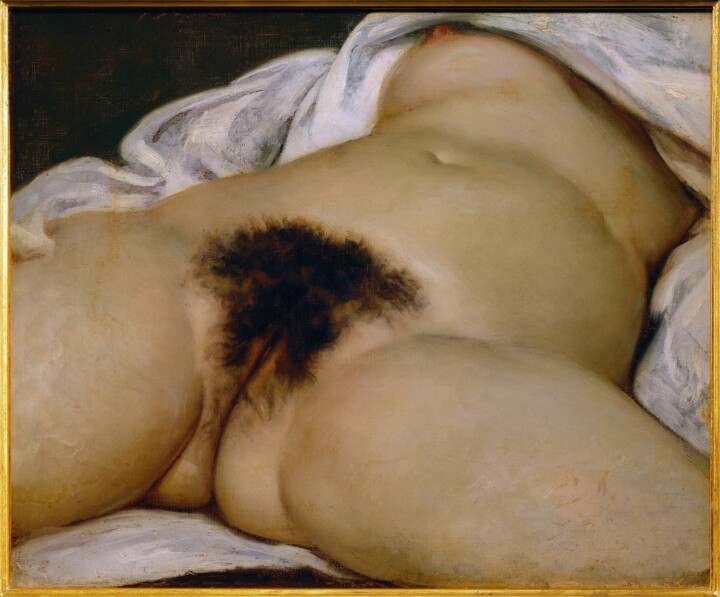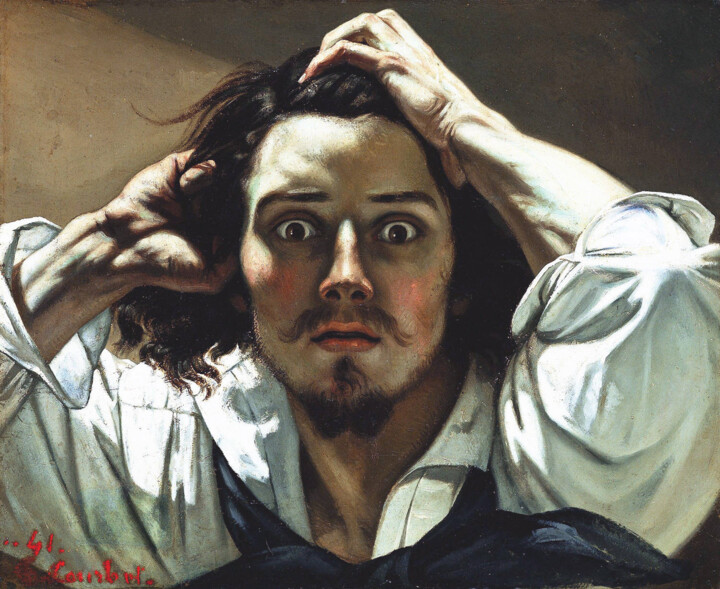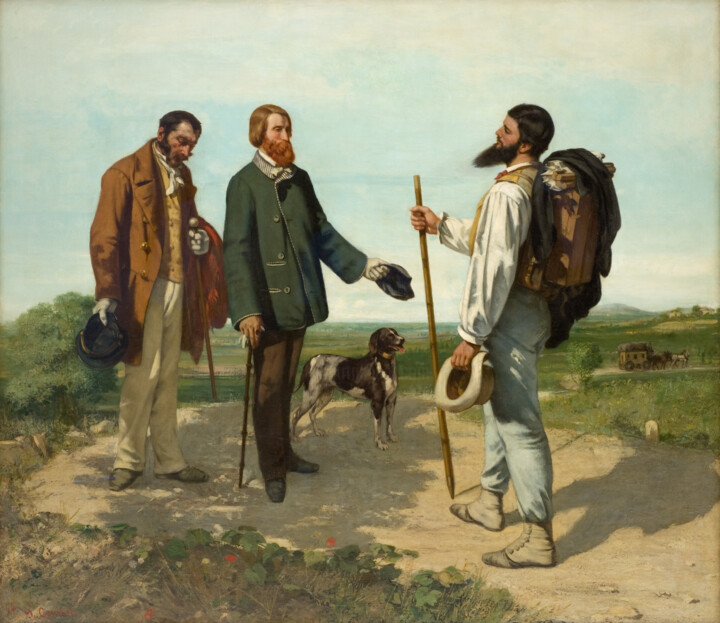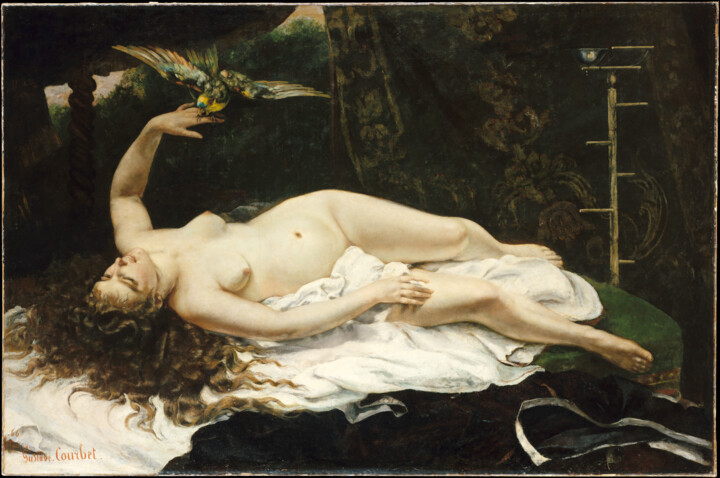 Gustave Courbet, Self-portrait (Man with Pipe), 1848-1849. Oil on canvas, 45 x 37 cm.
Gustave Courbet, Self-portrait (Man with Pipe), 1848-1849. Oil on canvas, 45 x 37 cm.
Who was Gustave Courbet?
Jean Désiré Gustave Courbet was a French painter born in Ornans on June 10, 1819, and passed away on December 31, 1877, in La Tour-de-Peilz. He is widely recognized as the most prominent representative of the Realism movement, and is often credited with coining the term itself. Courbet's oeuvre includes figurative compositions, earthly landscapes, seascapes, and depictions of women, while also addressing social issues such as the living and working conditions of peasants and the poor.
 Gustave Courbet, The Stone Breakers, 1849. Oil on canvas, 159×259 cm. Work destroyed during the bombing of Dresden (1945).
Gustave Courbet, The Stone Breakers, 1849. Oil on canvas, 159×259 cm. Work destroyed during the bombing of Dresden (1945).
The style
Gustave Courbet is regarded as the founder and primary proponent of French Realism, a style of painting that aimed to accurately represent reality without embellishment. His paintings are characterized by their high degree of truth to life, captured through spontaneous compositions and subjects devoid of artificial posing or decorum. Courbet's rejection of traditional standards of beauty and his focus on everyday life elevated previously overlooked subjects to the realm of high art. In addition to his artistic vision, Courbet's technique was physical and tactile, utilizing thick layers of paint mixed with sand applied with a palette knife to lend a palpable quality to his works. His influence on art history is far-reaching, with many artists, including the Impressionists, citing him as a source of inspiration. Édouard Manet, in particular, was influenced by Courbet's approach to the female nude, often causing controversy and public outrage. Other artists indebted to Courbet's legacy include Carolus-Duran, Antoine Guillemet, Henri Fantin-Latour, and Pierre-Auguste Renoir.
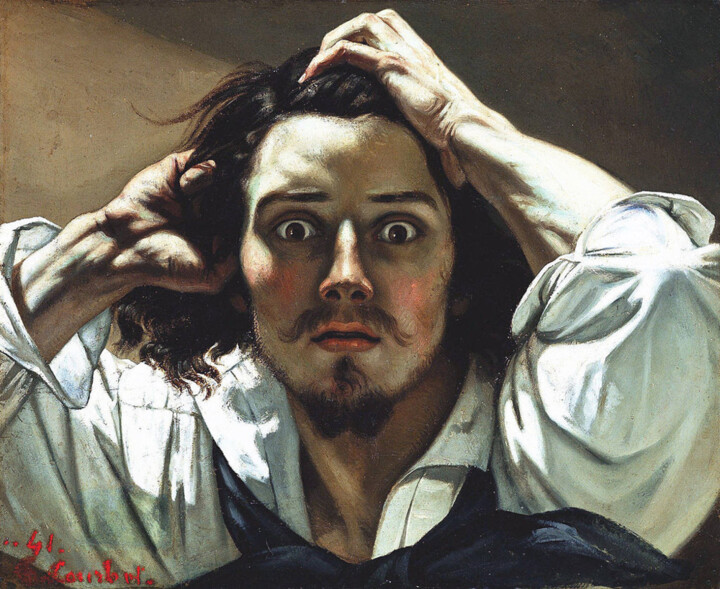 Gustave Courbet, Desperate Man, 1843-1845. Oil on canvas, 45×54 cm. Private collection.
Gustave Courbet, Desperate Man, 1843-1845. Oil on canvas, 45×54 cm. Private collection.
The Desperate Man
This painting depicts the artist with light shining on his face from the left side, creating an impression of anxiety or panic. The artist's left hand is stretched tightly and his eyes are wide open, staring directly at the viewer, creating a strong connection. The plain brown background helps to draw attention to his facial expressions and the folds and details of his white shirt are meticulously rendered. Courbet's close-up composition emphasizes the impact of the image, with only a small amount of background visible at the top left and top right of the painting.
 Gustave Courbet, Burial at Ornans, 1849. Oil on canvas, 315 cm × 660 cm. Paris: Musée d'Orsay.
Gustave Courbet, Burial at Ornans, 1849. Oil on canvas, 315 cm × 660 cm. Paris: Musée d'Orsay.
Light and expressiveness
The Desperate Man is a memorable portrait mainly due to the lighting and the artist's anguished expression. Its dramatic composition may remind some viewers of the works of Caravaggio and Rembrandt. Courbet held this painting dear to his heart and took it with him when he was forced into exile years later. It is now part of a private collection, but it has been lent out for public display on occasion. The painting is one of his most famous works, alongside The Stone Breakers, The Origin of the World, The Painter's Studio, and A Burial At Ornans, and continues to captivate art enthusiasts today, just as it did when it was first created. The Desperate Man is not only a significant part of Courbet's oeuvre but also one of the finest examples of 19th-century self-portraiture, frequently referenced in art history studies. It represents the artist's inner mood and self-reflection conveyed on canvas. Courbet produced several self-portraits throughout his career, indicating his fondness for this sub-genre.
 Gustave Courbet, The Wave, 1869-70.
Gustave Courbet, The Wave, 1869-70.
Size and medium
This self portrait is relatively small, measuring 55cm in width and 45cm in height (or 21 5/8 by 17 3/4 inches). Courbet likely kept it in his studio for many years, and the size may have contributed to this decision. The painting was completed using oil on canvas, which was a standard medium in 19th century French art. Courbet was known for his drawing skills and may have completed several sketches of himself before starting the painting. This approach would have helped him avoid making significant alterations later on. As far as we know, Courbet did not create any watercolor paintings.
Analysis
Art historians have examined The Desperate Man (Le Désespéré) and come to different conclusions about its meaning. Some believe it is an expression of Courbet's personality, while others suggest it was meant to bring the viewer closer to the subject. Courbet had created other self portraits that show similar anguish, but with the subject further back in the composition. The artist's study of other self portraits likely influenced his work in this sub-genre. Additionally, Courbet was struggling to gain academic recognition for his work at the time, having been rejected by the Salon in Paris. It's possible that this expressive piece represents his frustrations during that period. Overall, The Desperate Man (Le Désespéré) is significant not only in Courbet's oeuvre but also in the history of self portraiture.
 Gustave Courbet, The Bathers, 1853. Oil on canvas, 227 cm × 193 cm. Montpellier: Musée Fabre.
Gustave Courbet, The Bathers, 1853. Oil on canvas, 227 cm × 193 cm. Montpellier: Musée Fabre.
Influences
Courbet was a great admirer of several artists such as José de Ribera, Zurbaran, Velazquez, and Rembrandt. To better understand their techniques, he would spend time in the Louvre Museum in Paris, carefully studying their works by observing them up close and from a distance. This was a common practice among artists, as some would produce reproductions of famous paintings as a means of financing their own creative work. As Courbet did not undergo extensive formal training, visiting museums and studying the works of masters was crucial for his artistic development. It is not uncommon for artists to draw inspiration from previous generations, and this organic artistic influence can be observed throughout art history.
History
Gustave Courbet's self-portrait, The Desperate Man (Le Désespéré), reflects his frustrations at the time he painted it, having been rejected several times by the Salon in Paris. Despite his self-belief, he found it hard to come up short. The painting became a favorite of his and he kept it in his studio for the rest of his life. Courbet would become one of the finest French artists of the 19th century, re-visiting self-portraiture many times as his career developed. He achieved success and recognition in the late 1840s, particularly for his devotion to working-class subjects, bringing something new to French art. His socialist beliefs are evident in his earlier works, but later he explored other genres, such as still lifes and landscapes. He left behind an impressively diverse selection of oil paintings, which continue to captivate art enthusiasts. Courbet's self-obsession is evident in his self-portraits, but he was not so self-obsessed that he couldn't look outwards, and he studied the natural world and other subjects with great success. His legacy has remained strong, particularly in France, where he is highly revered. The Desperate Man (Le Désespéré) is considered the best of his self-portraits, connecting us directly to the artist's soul and helping us to understand the factors that motivated him to create. The use of light and the layout of the composition make it particularly memorable, with Courbet dominating almost the entire canvas. He was highly regarded by fellow artists, and several of his students went on to have successful careers of their own.
 Gustave Courbet, The Painter's Studio, 1855. Oil on canvas, 361 cm × 598 cm. Paris: Musée d'Orsay.
Gustave Courbet, The Painter's Studio, 1855. Oil on canvas, 361 cm × 598 cm. Paris: Musée d'Orsay.
Location
The Desperate Man (Le Désespéré) is currently held in a private collection owned by Conseil Investissement Art BNP Paribas. Due to its status as part of a private collection, the painting is not generally available for public viewing. However, it has been occasionally loaned out for exhibition purposes. The Conseil Investissement Art BNP Paribas is based in Paris, France, and it is likely that the painting is primarily stored there. Information regarding the painting's ownership history is limited, as much of the available documentation is in French and untranslated.
Exhibitions
The Desperate Man (Le Désespéré) is not frequently displayed in public, but it has been showcased in various exhibitions. A major exhibition entirely dedicated to Gustave Courbet was held at the Musée d'Orsay from October 13th, 2007 to January 28th, 2008, featuring The Desperate Man (Le Désespéré) as one of the highlights. This event was significant in raising awareness about Courbet's work and influence among younger generations of artists. The exhibition, which included 120 paintings and 30 drawings, later traveled to the Metropolitan Museum of Art, New York, and the Musée Fabre, Montpellier, where it was on display for several months. Other notable pieces displayed in the exhibition included Burial at Ornans and The Artist's Studio.
 Gustave Courbet, Self-portrait (Man with Pipe), 1848-1849. Oil on canvas, 45 x 37 cm.
Gustave Courbet, Self-portrait (Man with Pipe), 1848-1849. Oil on canvas, 45 x 37 cm.
Gustave Courbet's Self Portraits
Gustave Courbet was a self-obsessed artist, as he once described himself as the proudest and most arrogant man in all of France. This trait led to a number of self-portraits in his body of work, which varied in style and composition. In The Desperate Man, he is shown up close, while in other examples, he is depicted outdoors within landscapes. His self-portraits typically involved him looking directly at the viewer, whereas his other portraits varied. Courbet was considered an attractive man, which may have added to his ego and made him an excellent model for his own work. He was also highly regarded as a skilled portrait painter and experimented with different genres, ultimately becoming respected as a landscape painter as well.
Self Portraiture
Self-portraiture is a unique art genre that can reveal a lot about an artist's character and motivations. For artists like Courbet, their self-portraits provide insight into their careers and personal lives. Courbet's interest in the works of other artists, like Rembrandt, is reflected in his own paintings. The Louvre was a particularly important resource for Courbet's studies. While some artists have made careers out of self-portraiture alone, it is not common. Rembrandt, for example, produced many self-portraits to supplement his income. Self-portraiture can also be a form of introspection and therapy, as seen in the case of Van Gogh, whose mental instability is well-known. Ultimately, self-portraits provide a unique window into an artist's personal and artistic life, making them an important aspect of art history.


 Selena Mattei
Selena Mattei

